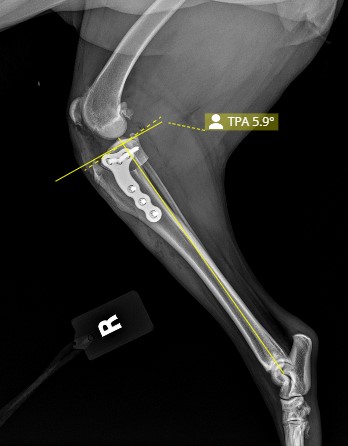At The Hometown Veterinarian in Marshalltown, Iowa, we offer Tibial Plateau Leveling Osteotomy (TPLO) surgery to treat dogs suffering from cranial cruciate ligament injuries. This procedure is considered a gold standard for CCL repair, producing excellent long-term results. Dr. Grant Jacobson has completed Securos PAX system training, ensuring advanced expertise in performing TPLO surgery with precision and care.
What is TPLO Surgery?
TPLO surgery is an advanced surgical procedure that stabilizes the knee by altering the anatomy of the tibia, eliminating the need for the damaged cranial cruciate ligament. Unlike traditional ligament repair, TPLO changes the knee structure to function without the ligament, resulting in a more durable and long-lasting solution.
In the procedure:
- A curved cut is made at the top of the tibia.
- The top portion of the bone is rotated and secured with a titanium locking plate and screws.
- This technique redirects the forces exerted during walking, preventing the tibia from sliding forward and restoring proper knee function.
 How Does TPLO Work?
How Does TPLO Work?
By changing the angle of the tibia, the knee joint functions naturally as a hinge again, without relying on the damaged ligament. This anatomical adjustment allows dogs to walk and run without pain, ensuring a faster and more reliable recovery compared to suture-based techniques.
Securos PAX Polyaxial Locking TPLO Plate System
At The Hometown Veterinarian, we use the Securos PAX Polyaxial Locking TPLO plate system, which offers significant advantages for post-surgical recovery:
- Stability: The polyaxial locking system allows the plate and screws to lock together at multiple angles, providing enhanced stability and reducing the risk of movement during the healing process.
- Reduced Risk of Infection: Titanium implants are known for their resistance to corrosion and infection, making them an ideal choice for TPLO surgery.
- Customizable Fit: The polyaxial design allows the plate to be positioned more flexibly, ensuring a customized fit to your dog’s anatomy, which improves surgical outcomes.
With Dr. Jacobson's specialized Securos PAX system training, we provide a cutting-edge solution for dogs needing CCL repair.
Is TPLO Surgery Right for My Dog?
Both TPLO and Tibial Tuberosity Advancement (TTA) surgeries are highly effective for treating CCL injuries. The choice between these procedures depends on factors such as your dog’s anatomy.
TPLO surgery is considered superior to traditional suture-based techniques because it offers a more durable, long-term solution. Suture-based repairs rely on artificial ligaments, which can weaken or break over time, often requiring additional surgeries. In contrast, TPLO modifies the bone structure itself, providing a permanent correction that eliminates the need for the damaged ligament entirely, resulting in a quicker recovery and lasting stability.
With Dr. Jacobson's specialized training in the Securos PAX system, we offer an advanced level of care and will recommend the most appropriate option for your dog after a thorough evaluation.
TPLO Surgery Recovery: Questions & Answers
How long is the recovery after TPLO surgery?
Most dogs begin bearing weight within the first week, but full recovery typically takes around 8–12 weeks. It’s critical to follow your veterinarian’s instructions closely and attend all recheck appointments to ensure proper healing.
When can my dog start walking again after TPLO surgery?
Short, controlled leash walks can usually begin after the first 2 weeks. These walks start with very short distances (about one block) and gradually increase each week, depending on your dog’s comfort level and healing progress.
Can my dog use stairs after TPLO surgery?
Stairs may be used with caution and direct supervision, with a leash on the dog to ensure no fall occurs. During the initial 4-week recovery period, it’s best to limit stair use as much as possible. If stairs are unavoidable, provide steady guidance and support to prevent slipping or injury.
Is it normal for my dog to still have pain after surgery?
Mild discomfort is possible in the early stages of healing but should be well-controlled. At The Hometown Veterinarian, we use a multi-modal approach to pain management to keep your dog as comfortable as possible. If your pet seems unusually uncomfortable or their pain worsens, please contact us for further evaluation.
When will the stitches come out?
Sutures are typically removed 10–12 days after surgery during a follow-up appointment.
Can my dog swim or do hydrotherapy after TPLO?
Hydrotherapy can be beneficial in weeks 7–8 of recovery but should be limited to shallow, closely monitored sessions. Avoid swimming in deep water or overexertion, which can lead to inflammation.
What happens if my dog starts running too soon?
Letting your dog run before the bone has fully healed may cause pain, re-injury, or implant complications. Always restrict off-leash activity until cleared by the veterinarian, typically after the 8-week recheck X-ray.
Is it necessary to take a follow-up X-ray?
Yes. A follow-up X-ray, typically performed around 8 weeks after surgery, is essential to confirm proper healing of the bone and surgical site. This imaging helps the veterinarian determine when it is safe to increase your dog’s activity level and ensures long-term success of the TPLO procedure.
What can I do to help my dog heal faster?
Stick closely to all recovery instructions—these are designed to protect your dog during the most critical phases of healing. Use ice and heat therapy as directed, restrict activity, and attend all scheduled follow-up appointments. We strongly recommend laser therapy to reduce inflammation, manage pain, and promote tissue regeneration. Most TPLO patients benefit from twice-weekly laser sessions for the first few weeks post-op. In addition, physical rehabilitation techniques—such as guided range-of-motion exercises and structured leash walks—can greatly enhance recovery and help your dog regain strength and mobility more quickly.
Schedule a Consultation
If your dog is suffering from a CCL injury, TPLO surgery may provide the relief and recovery needed.
